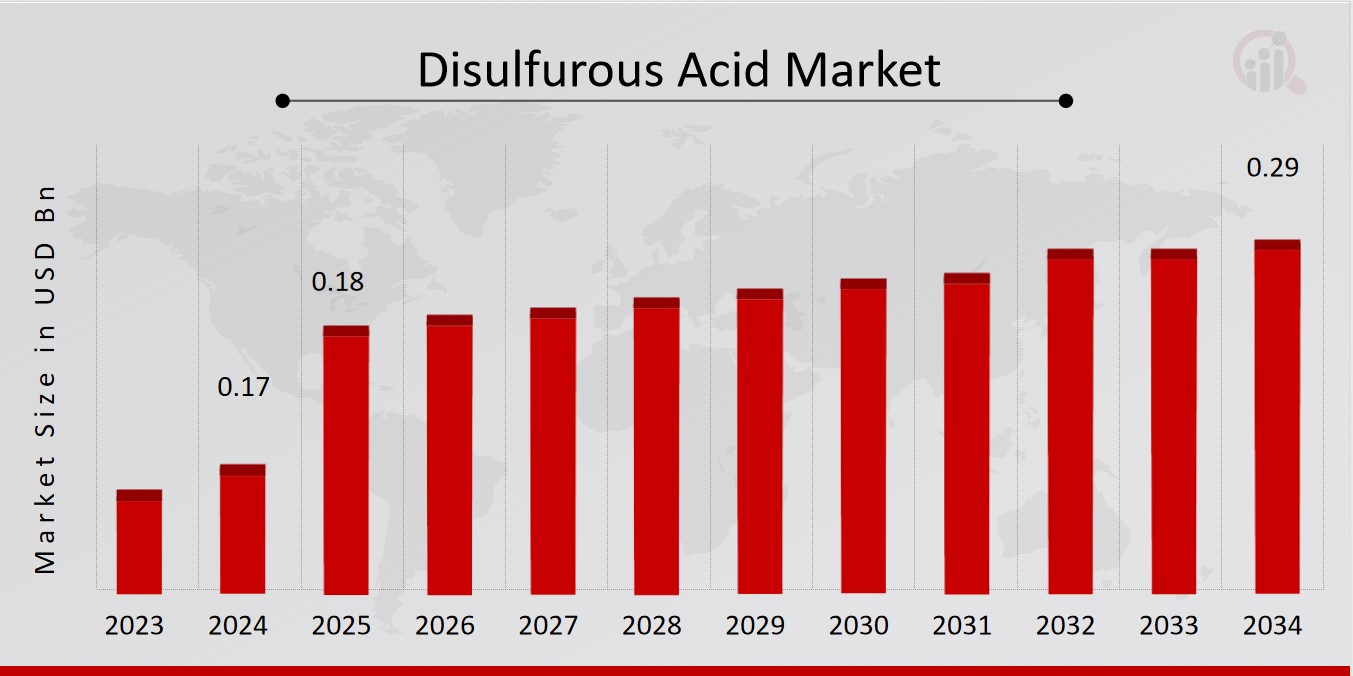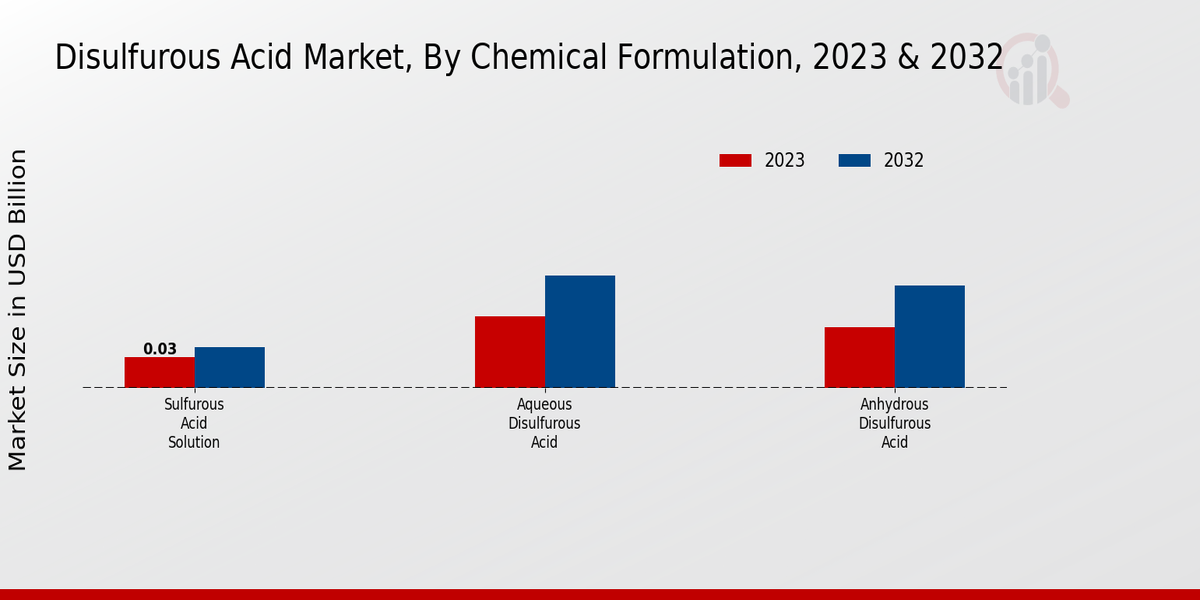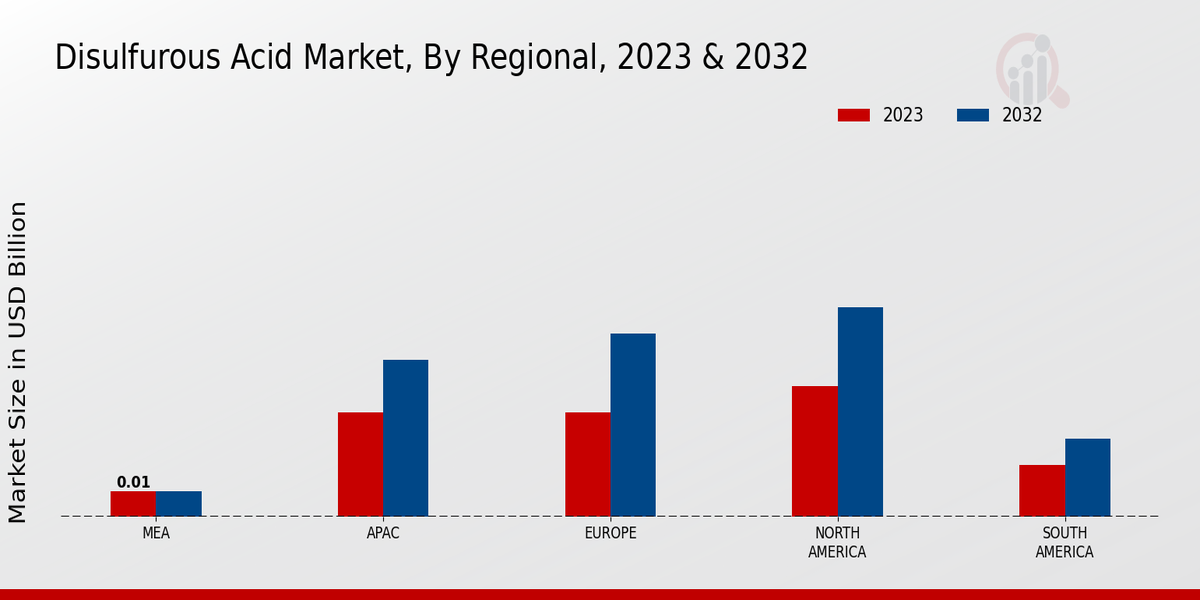Global Disulfurous Acid Market Overview
The disulfurous acid market size was estimated at 0.17 (USD billion) in 2024. The disulfurous acid industry is expected to grow from 0.18 (USD billion) in 2025 to 0.29 (USD billion) by 2034. The disulfurous acid market CAGR (growth rate) is expected to be around 5.16% during the forecast period (2025-2034).
Key Disulfurous Acid Market Trends Highlighted
The disulfurous acid market is witnessing significant growth driven by the increasing demand for sulfur-based chemicals in various industrial applications. Key market drivers include the rising awareness of environmental regulations, which has stimulated interest in more sustainable chemical processes. The expansion of the pharmaceutical industry, where disulfurous acid is employed as a reducing agent, further propels this market. The booming agrochemical sector, particularly in the production of pesticides and herbicides, is another factor contributing to the demand. As industries strive to develop greener products, the versatility of disulfurous acid presents a promising avenue.
Opportunities abound for stakeholders looking to capitalize on the expanding applications of disulfurous acid. Emerging markets in developing regions are likely to experience heightened interest, as industrialization increases and the need for agricultural productivity grows. Ongoing research and development efforts focused on improving the efficiency of disulfurous acid synthesis could enhance its competitiveness against alternative compounds. Many companies are exploring synergies with other industries to maximize the utility of disulfurous compounds, opening innovative applications.
In recent times, the market has seen an evolution in production methods, sparked by advancements in technology and an increase in collaborations among manufacturers. Companies are now emphasizing sustainability, leading to the adoption of eco-friendly practices in the production and usage of disulfurous acid. This shift reflects a broader trend within the chemical industry towards reducing environmental footprints while maintaining efficiency and output. As more businesses recognize the benefits of aligning with sustainable practices, the disulfurous acid market is positioned for further exploration and growth.

Source: Primary Research, Secondary Research, MRFR Database and Analyst Review
Disulfurous Acid Market Drivers
Increasing Demand from the Chemical Industry
The market is experiencing heightened demand primarily driven by the chemical sector. Disulfurous acid is predominantly used as a reagent in various chemical reactions and synthesis processes. Its applications range from acting as an effective reducing agent to serving as a precursor to produce several sulfur-containing compounds. The growth of this sector is significantly influencing the market, as industries focus on improving efficiency, reducing costs, and enhancing product quality.
The ongoing advancements in chemical processes and manufacturing technologies have further propelled the utilization of disulfurous acid. This includes the production of agrochemicals, plastics, and pharmaceuticals where disulfurous acid plays a pivotal role. Additionally, the increased emphasis on sustainable and environmentally friendly production methods is pushing companies to explore disulfurous acid as an alternative to more hazardous substances.
As these chemical industries expand due to globalization and rising population demands, the market is projected to follow suit, reflecting a strong growth trajectory in the years ahead. The chemical sector's reliance on disulfurous acid will not only sustain its current demand but also foster innovation in applications, driving the overall market growth.
Growing Environmental Awareness and Regulations
With the increasing focus on environmental sustainability and stringent regulations, the disulfurous acid market is set to benefit. Many countries and regions are implementing policies to reduce pollution and promote the use of cleaner chemicals, which includes promoting substances like disulfurous acid that can perform similar functions with reduced environmental impact. This shift in regulatory landscape is pushing industries toward adopting safer, environmentally friendly alternatives, which is fostering market growth for disulfurous acid due to its favorable eco-profile.
Expanding Applications in Agriculture
The agricultural sector is increasingly recognizing the advantages of disulfurous acid, particularly in pest control and soil treatment. As the demand for sustainable agricultural practices grows, disulfurous acid is being developed into effective agrochemical formulations. Its role in enhancing soil health while being less harmful than conventional agents positions it as a desirable option for farmers looking to reduce their environmental footprint.
Disulfurous Acid Market Segment Insights:
Disulfurous Acid Market Chemical Formulation Insights
The chemical formulation segment of the disulfurous acid market reflects significant growth and evolution driven by diverse applications across various industries. The market is segmented into anhydrous disulfurous acid, aqueous disulfurous acid, and sulfurous acid solution.
The aqueous disulfurous acid segment holds considerable relevance, with a market valuation of 0.07 USD billion in 2023, projected to grow to 0.11 USD billion by 2032, indicating its utilization in various applications, particularly in the food and beverage industry and water treatment processes.
The anhydrous disulfurous acid segment, valued at 0.06 USD billion in 2023 and anticipated to rise to 0.1 USD billion by 2032, is critical in chemical manufacturing and acts as an important reducing agent. It has a significant standing in the pulp and paper industry, where it helps in the production of chemicals needed for various processes.
The sulfurous acid solution segment, while valued at 0.03 USD billion in 2023 and expected to reach 0.04 USD billion by 2032, plays a vital role in agricultural applications and is widely used as a preservative and disinfectant. The majority holding in the market can be attributed to the aqueous disulfurous acid due to its extensive utility in industrial processes and treatments. The increasing demand for environmentally friendly chemical solutions and sustainable practices has created ample opportunities for market players in this segment.

Source: Primary Research, Secondary Research, MRFR Database and Analyst Review
Disulfurous Acid Market Application Insights
Based on applications, food preservation utilizes disulfurous acid for its effective antimicrobial properties, ensuring longer shelf life for perishable products, while water treatment employs it to remove contaminants and manage pollutants, contributing to environmental safety. Chemical manufacturing relies heavily on disulfurous acid as a vital reagent in synthesizing various chemicals, thus driving its demand further.
The textile industry benefits from its usage as a bleaching agent, enhancing quality and color consistency in fabric production. Pulp and paper production sees disulfurous acid as a key player in the bleaching process, improving the quality of paper products.
As these applications continue to evolve and grow, the overall disulfurous acid market revenue is projected to increase, reflecting the importance of this compound in enhancing production processes and environmental sustainability. The market growth can also be attributed to the rising demand in these applications, supported by ongoing innovations and regulatory influences focused on sustainable practices.
Disulfurous Acid Market End User Industry Insights
Disulfurous acid is used for several purposes in various end user industries, including pharmaceuticals, agriculture, energy, and manufacturing. The pharmaceutical sector emerges as a significant consumer, benefiting from disulfurous acid's utility in chemical synthesis and production processes. Agriculture also holds a substantial position, leveraging disulfurous acid for its applications in crop protection and soil treatment.
The energy sector recognizes the importance of this market for its use in producing energy-efficient methods and reducing emissions. The manufacturing industry has been enhancing its operations through the integration of disulfurous acid in processing methods, promoting higher efficiency and performance.
Disulfurous Acid Market Purity Level Insights
The disulfurous acid market is categorized into different purity levels, including low purity, medium purity, and high purity. High purity disulfurous acid tends to dominate due to its critical role in industries such as pharmaceuticals and electronics, where product quality is paramount.
Medium purity standards are increasingly favored in agricultural applications, showcasing their versatility. Low purity products find significant use in environmental applications, highlighting their importance in sustainability efforts.
Disulfurous Acid Market Packaging Type Insights
The packaging type aspect of the market plays a crucial role in facilitating safe storage and transportation, which is paramount for maintaining the integrity of disulfurous acid. Drums, bulk containers, and cylinders are the primary forms of packaging, with barrels facilitating smaller quantities while bulk containers accommodate larger volumes. The use of cylinders is significant as they provide ease of handling and efficient delivery for industrial needs.
Each of these forms is vital in different sectors, catering to diverse logistical requirements and regulatory compliance. The market growth is buoyed by an increasing demand from emerging economies, though challenges such as stringent regulations concerning chemical transportation may arise.
Disulfurous Acid Market Regional Insights
North America led the market in value at 0.05 USD billion in 2023, expected to reach 0.08 USD Billion by 2032. Europe follows closely with a valuation of 0.04 USD billion in 2023, projecting growth to 0.07 USD billion in the coming years.
The Asia Pacific, while currently valued at 0.04 USD billion, is anticipated to grow to 0.06 USD billion, highlighting its significant potential for market expansion. South America holds a valuation of 0.02 USD billion in 2023, expected to increase to 0.03 USD billion, indicating a slow but steady growth trajectory.
The Middle East and Africa exhibit the smallest representation in the market, valued at 0.01 USD billion for both 2023 and 2032. The market growth is influenced by factors such as increased industrial application, growing awareness regarding environmental benefits, and advancements in production technologies. However, challenges like regulatory constraints and market entry barriers may pose limitations.

Source: Primary Research, Secondary Research, MRFR Database and Analyst Review
Disulfurous Acid Market Key Players and Competitive Insights:
The disulfurous acid market is characterized by a complex interplay of demand and supply dynamics driven by various industrial applications such as chemical manufacturing, agriculture, and waste treatment. As industries increasingly seek cost-effective and environmentally friendly alternatives, disulfurous acid has garnered attention due to its unique properties and usability in a range of chemical processes.
The competition in this market is stark, with several players vying for market share by enhancing their production capabilities, engaging in strategic partnerships, and focusing on research and development to innovate products that cater to the evolving needs of consumers. This rapidly growing market is influenced by regional economic factors, regulatory frameworks, and emerging technological trends that dictate competitive positioning among key players.
Huntsman stands out in the market due to its robust approach to quality assurance and innovation. The company has developed advanced manufacturing processes that not only ensure high purity levels of disulfurous acid but also enhance the efficacy of its applications. Huntsman's notable strength lies in its extensive expertise in specialty chemicals, allowing it to tailor its products to meet the specific needs of customers across diverse sectors.
The company's distribution network ensures a steady supply to various regions, making it a preferred partner in both established and emerging markets. Moreover, Huntsman emphasizes sustainability by implementing eco-friendly practices throughout its production processes, which resonates well with environmentally conscious consumers and contributes to its competitive edge.
Solvay, similarly, brings significant strengths to the Disulfurous Acid Market with its commitment to innovation and sustainable solutions. The company holds a strong market presence anchored by years of experience and a broad portfolio of specialty chemicals. Solvay differentiates itself by investing heavily in research and development, positioning itself as a leader in enhancing the efficiency and application scope of disulfurous acid.
This dedication to innovation allows Solvay to stay ahead of market trends and meet the evolving demands of its clientele. Solvay is recognized for its strategic collaborations with other industry players and research institutions, which facilitates technology transfer and accelerates product development. This collaborative approach not only amplifies the company's market reach but also solidifies its reputation as a key contributor to sustainable industrial practices in the landscape.
Key Companies in the Disulfurous Acid Market Include:
Disulfurous Acid Market Developments
Recent developments in the disulfurous acid market have been characterized by increasing applications across various industries, notably in the production of specialty chemicals and as a reducing agent in wastewater treatment. The market is witnessing a gradual shift towards sustainable practices, prompting manufacturers to enhance production processes to minimize environmental impacts.
Rise in demand for disulfurous acid in the pharmaceutical sector due to its importance in certain chemical syntheses has garnered attention. Regulatory frameworks focused on environmental safety are also influencing market dynamics, with industries exploring alternative solutions that comply with stringent regulations.
Technological advancements have facilitated improved manufacturing efficiencies and product quality, aligning with the growing trend for innovation in chemical production. The market is expected to expand significantly, driven by robust growth in emerging economies, where industrialization and urbanization are on the rise, creating new opportunities for disulfurous acid utilization. As companies adapt to the evolving regulatory landscape, collaboration and research initiatives will likely play a crucial role in addressing market challenges while capitalizing on growth potential.
Disulfurous Acid Market Segmentation Insights
Disulfurous Acid Market Chemical Formulation Outlook
Disulfurous Acid Market Application Outlook
Disulfurous Acid Market End User Industry Outlook
-
Pharmaceuticals
-
Agriculture
-
Energy
-
Manufacturing
Disulfurous Acid Market Purity Level Outlook
-
Low Purity
-
Medium Purity
-
High Purity
Disulfurous Acid Market Packaging Type Outlook
-
Drums
-
Bulk Containers
-
Cylinders
Disulfurous Acid Market Regional Outlook
-
North America
-
Europe
-
South America
-
Asia Pacific
-
Middle East and Africa
| Report Attribute/Metric |
Details |
| Market Size 2024 |
0.17 (USD Billion) |
| Market Size 2025 |
0.18 (USD Billion) |
| Market Size 2034 |
0.29 (USD Billion) |
| Compound Annual Growth Rate (CAGR) |
5.16% (2025-2034) |
| Report Coverage |
Revenue Forecast, Competitive Landscape, Growth Factors, and Trends |
| Base Year |
2024 |
| Market Forecast Period |
2025-2034 |
| Historical Data |
2020-2024 |
| Market Forecast Units |
USD Billion |
| Key Companies Profiled |
Huntsman, Solvay, BASF, Kraton Corporation, Arkema, Tosoh Corporation, Cytec Industries, Olin Corporation, Eastman Chemical Company, Lanxess, Motiva Enterprises, SABIC, Albemarle, Mitsubishi Gas Chemical Company |
| Segments Covered |
Chemical Formulation, Application, End User Industry, Purity Level, Packaging Type, Region |
| Key Market Opportunities |
Growing demand in chemical synthesis Expansion in water treatment applications Increased use in pharmaceutical manufacturing Rising interest in sustainable processes Development of agricultural products |
| Key Market Dynamics |
Rising industrial applications Environmental regulations and compliance Volatile raw material prices Growing demand in pharmaceuticals Expansion of regional production capabilities |
| Countries Covered |
North America, Europe, APAC, South America, MEA |
Frequently Asked Questions (FAQ) :
The disulfurous acid market is expected to reach a valuation of 0.29 USD billion by 2034.
The market is projected to grow at a CAGR of 5.16% from 2025 to 2034.
North America is anticipated to hold the largest share, reaching 0.08 USD billion by 2032.
Anhydrous disulfurous acid demand is slated to be valued at 0.1 USD billion by 2032.
The aqueous disulfurous acid segment is expected to reach a market size of 0.11 USD billion by 2032.
The sulfurous acid solution segment is estimated to reach 0.04 USD billion by 2032.
Key players include Huntsman, Solvay, BASF, Kraton Corporation, and Arkema.
Europe is expected to yield a valuation of 0.07 USD billion by 2032.
The market in South America is expected to reach 0.03 USD billion by 2032.
The market in Asia Pacific is projected to have a market value of 0.06 USD billion by 2032.

















